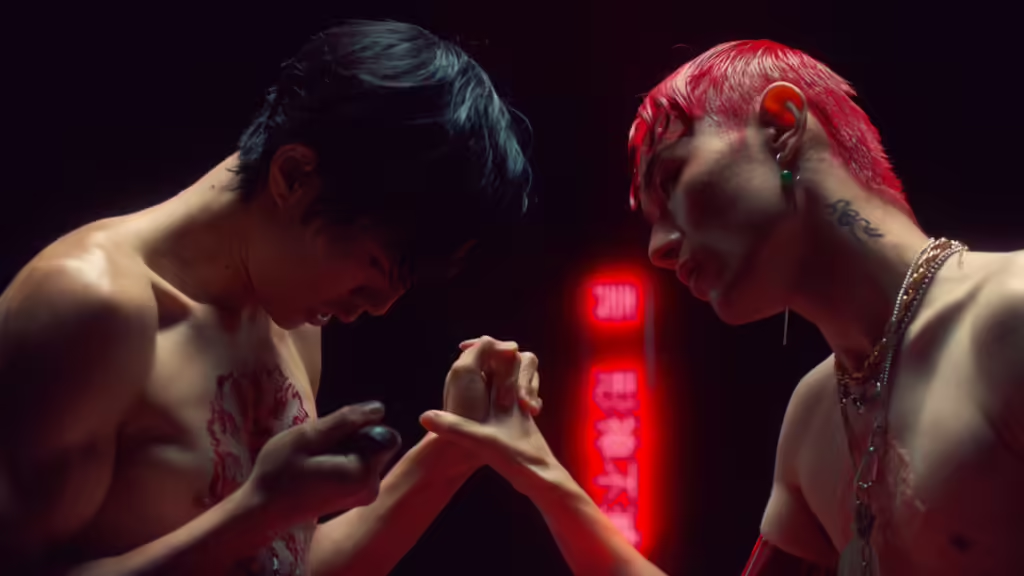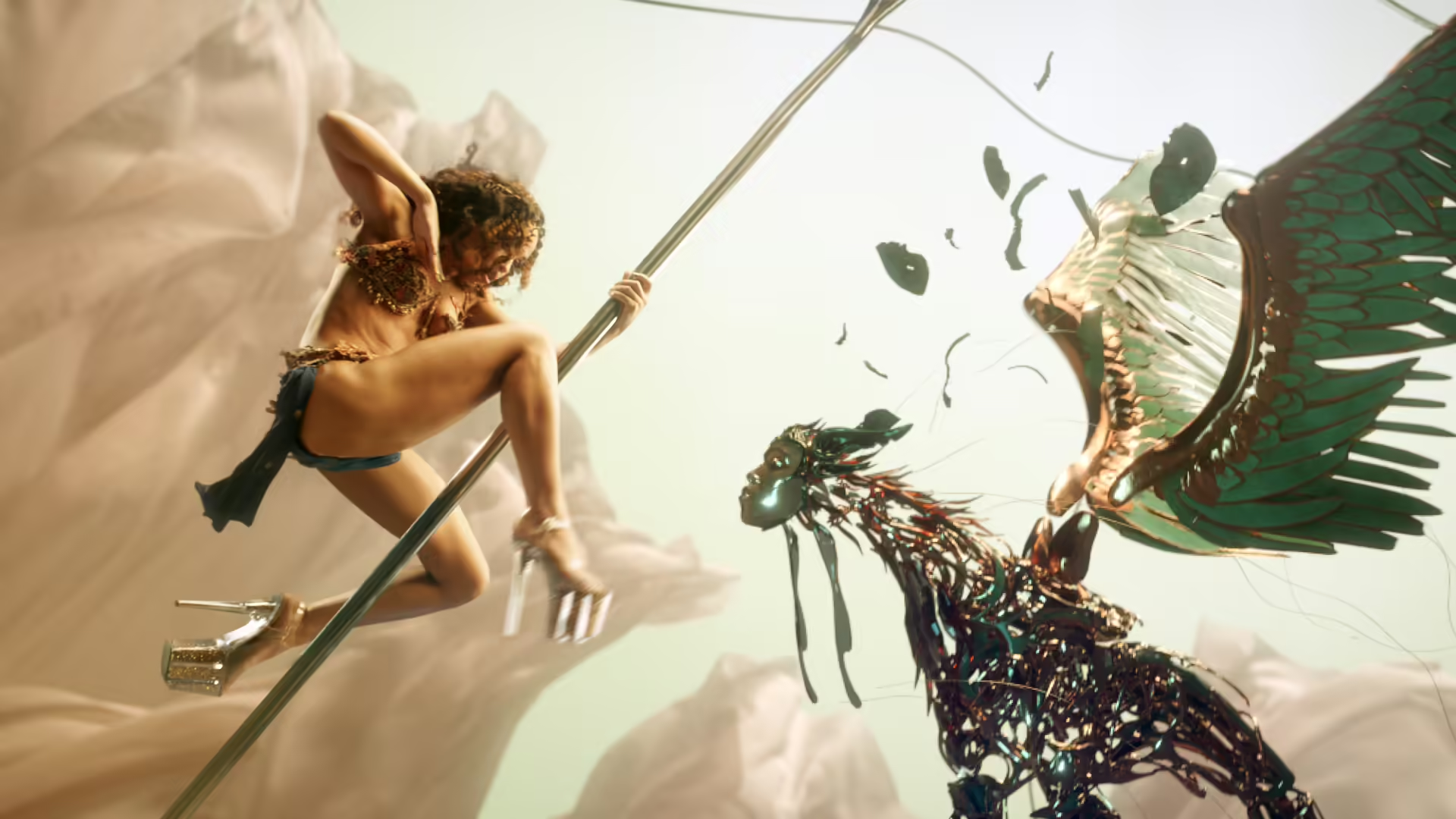Words by: Cat Woods
In June, musician Sasami’s official video for her anthemic love song “Honeycrash” brought a burst of cosmic wonder, featuring thunder, lightning, meteors, tidal waves, and wild horses. It’s a whirlwind of chaos, beauty, and vulnerability into just a few minutes. The video is the latest collaboration between Sasami and writer-director Andrew Thomas Huang, whose work is known as lush, beautiful, cinematic and sensuous. Huang’s impressive portfolio also includes collaborations with Björk, FKA Twigs, Kelela, serpentwithfeet, and Sigur Rós, in addition to his own artwork and films.
Based in LA, Huang excels in multimedia projects that blend live action, motion capture, visual effects, and simulation-driven animation. His work often incorporates motifs from Chinese mythology, featuring futuristic creatures that merge human and real or imagined deities.
Huang’s 2019 film Kiss of the Rabbit God explores the story of a young restaurant worker who is visited nightly by the Rabbit God— an 18th-century Qing dynasty deity who is personified by an ethereally beautiful young man. The film is both a personal homage to Huang’s own background and a powerful narrative about queer Asian love, filling a noticeable gap in the representation of such stories.
“This film is super close to me. I made it the same year I made “Cellophane” [with FKA Twigs]. Rabbit God was, by far and away, much more emotionally difficult and vulnerable to make,” he tells CONE. “It was the first time I told a queer Asian story and injected personal autobiographical and family history into the narrative. My family used to own a Chinese restaurant for 40 years, and I set the film against that backdrop, which felt really personal to recreate the sensations I remember as a kid. The film also deals with sexual desire, shame, and insecurity, which the Rabbit God unlocks. So, this film was a sort of queer coming-of-age confession drawn from my own coming out experience, and it took a lot out of me to make it. But I felt forever changed by making it and am overwhelmed by the positive responses from my own community.”
“Cellophane” received overwhelmingly positive responses. In the wake of her breakup with actor Robert Pattinson, while coping with health challenges of fibroid tumors that required invasive surgery, FKA Twigs created this video a sense of empowerment and joy in her own body. Her breathtaking mastery of pole dancing is testament to her artistry. “In another life, I wish I was a dancer,” Huang says, half-jokingly.
Huang shares a similar passion for performance in his work. “I care very much about an artist’s presence in a video. I think fans want to see their face and want to see them embody the music as performers,” he explains. “I really get a kick out of letting great performers do their thing. So performance is always something I try to integrate in all my work and I thoroughly enjoy it.”
Two years earlier, Huang released the video for Björk’s “The Gate” in 2017, followed by “Ancestress” in 2022. Both mini-films offered fantastical scenarios, where Björk inhabits either a distant, pre-industrial world or a futuristic, digital nirvana. Huang avoids a default style, instead crafting unique worlds and narratives tailored to each artist and each video.
“I listen to the content of the song and ask myself what the music is ultimately about,” he explains of shaping each world in his videos. “Before ‘Ancestress,’ for example, Björk and I made ‘The Gate,’ which was a sci-fi utopian world that required full-guns-blazing visual effects to give us the richness of this far out imaginary universe. But ‘Ancestress’ was such a personal song about Björk’s late mother.” Huang notes that creating deeply personal and sensitive material “requires an honesty and authenticity,” which is why he felt “capturing a funeral eulogy on camera required a kind of nakedness that only a simple raw performance against the natural landscape could do best.”
On the other hand, he says, “’Cellophane’ was kind of in-between.” I wanted her pole performance to really be the centerpiece. But as an emotional song about failure and humility, I wanted to stage the performance within the language of poetic realism, so it is still her dancing, but the dance is a duet with heaven and hell filled with digital angels and clay witches for her soul to reckon with.”
Huang’s collaborations with FKA Twigs and Björk epitomize the dark, dramatic and sensual vibe of his vision. His work is truly collaborative, reflecting a shared creative process. This approach has attracted other artists who explore similar themes, such as serpentwithfeet and Kelela. Decades ago, fashion designer Alexander McQueen’s “Savage Beauty” collection celebrated the beauty found in nature’s violence and brutality. Huang finds a parallel in McQueen’s reference and wonders if, like McQueen, he too is drawn to darkness.
“McQueen’s ‘Savage Beauty’ is such a seminal influence. I’ve actually been thinking a lot about the term ‘darkness’, which I have always inherently been drawn to,” the filmmaker reflects. “I think when the word ‘dark’ is used as a pejorative, there is risk of perpetuating colorism embedded in the English language. But if we’re talking about darkness used in the positive sense, such as the ‘yin’ element that evokes the richness of the subconscious, the divine feminine, the wild mystery of nature, the vastness of space, the blackness of the deep ocean, the beauty of all things nocturnal—then absolutely I am drawn to darkness.”
Perhaps, as Huang suggests, he is drawn more to the mystery within darkness than to bleakness or desolation. This fascination mirrors the same ethereal, otherworldly wonderland that Björk conjures up in her music. Speaking fondly of their relationship, Hunags says, “Björk has been, by far, the longest and most personal relationship I have had the privilege of cultivating for over a decade. And it’s thanks to her generosity and trust.”

He continues, “I am a big fan of all of the musicians I have worked with, and would love the chance to work with everyone again and deepen our collaboration. In gig economies, it’s rare that we get to really foster deeper relationships with people, and we’re often expected to get along right away. Failure is an inevitable part of getting to know how someone else works. I think we all need more opportunities to fail and learn from each other. It would make us all better collaborators and better artists in the long run, and the work will ultimately be richer for it. It’s why I’m most proud of the most recent work I’ve done for Björk, because we made it when we were most synced. That’s the beauty of collaboration—when it feels like you’re flying together.”
That ability to connect deeply and collaborate effectively starts with a shared language: music. As Huang explains, “Ever since I was a kid, I voraciously consumed music. To this day, I am nonstop sifting through new stuff. I learned piano from a young age and did marching band and orchestra in high school. I also grew up on a diet of Motown from my parents and raided my sister’s CD collection, where I was introduced to Radiohead, Erykah Badu, Bjork, and Aimee Mann.”
He adds, “I watched MTV over my sister’s shoulder during the music video heyday in the late 90s, early 2000s. Then there was the Napster era, and I became obsessed with bands like Blonde Redhead, Sleater-Kinney, Deerhoof and alt electronic music like ADULT., Dntel, and Autechre. I was also obsessed with soundtracks, and Danny Elfman changed my life.” Reflecting on his journey, Huang concludes, “I feel so indebted to music, it’s the first time-based art form I fell in love with, and it is the reason why I’m a filmmaker.”
One of Huang’s recent collaborations has been with Sasami, starting with her 2022 Squeeze album, for which he created visualizers, album art, and videos. Huang reflects on their connection: “I was a fan of Sasami’s music for a while, and we intersected through a combination of mutual friends and internet DMs. We were surprised and delighted to realize that our parents actually went to high school together and we quickly bonded over growing up in religious Asian households in the South Bay of LA in Southern California.”
Their shared backgrounds and upbringing laid a solid foundation for their collaboration on the latest video for “Honeycrash.” Explaining the creative process behind the video, Huang says, “when Sasami first played the song for me, I could hear how sweeping and thunderously epic it was. It felt cinematic, and I knew that ‘Honeycrash’ was an anthem that deserved visuals that could live up to the bigness of Sasami’s sound.”
He notes the concept took considerable development and was inspired by several blockbuster films. “We were inspired by movies like Thelma & Louise and dystopian romantic imagery of the American West. At first, we wanted to shoot Sasami in a sports vehicle racing through the desert, but this was prohibitive with our limited budget,” Huang describes. “One of the riches of LA is being near state-of-the-art technology like the new LED volume stages used in shows like The Mandalorian. I realized that we could still create a portrait of Sasami against this wild crashing elemental backdrop if we used stock footage.”
To capture the song’s nu-metal influences, Huang embraced a mix of vintage and contemporary elements. “I leaned into the ‘cutty’ music video nostalgia of the 90s and leaned into the unapologetic romanticism of the stock footage to create a good old fashioned performance video with the latest tools available to us, and that’s how we ended up with the final piece,” he explains.
“Honeycrash,” like Huang’s previous works, including “Cellophane” and “The Gate”offers an escapist adventure in a world that increasingly feels miserable, violent, and unstable. In Huang’s vision however, beauty reigns.
“The violence and genocides happening around the world are so unspeakable, it’s hard to know how to operate day to day,” Huang acknowledges, reflecting on the current state of the world. Despite this, he finds motivation through his connections with others. “I get the most hope and inspiration from being around students and being in solidarity with like-minded friends. I feel so grateful to be friends with so many incredible artists. I call them my spiritual family.”
He cites filmmaker Céline Sciamma’s notion that “art is about the transmission of our intimacies.” For Huang, sharing art with friends—whether through collaboration or simply appreciating it together—allows their souls to connect. “As long as our souls can still touch,” he concludes, “then maybe we’ll be ok.”

